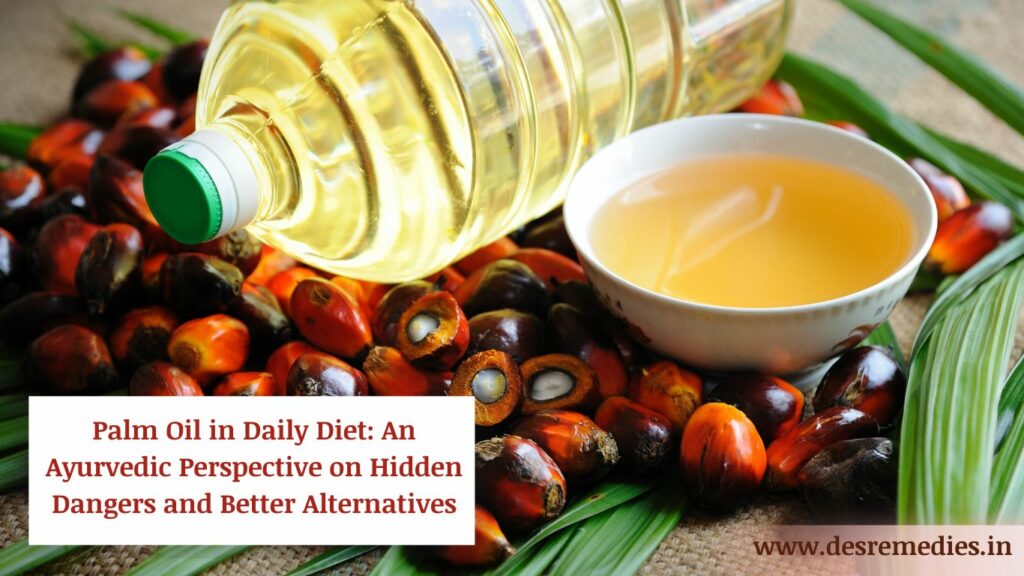
In our fast-paced lives, we often grab what’s convenient—packaged snacks, instant mixes, ready-made breads—without giving much thought to what they’re made of. But Ayurveda teaches us to pause and ask: Is this food sattvic (pure), rajasic (stimulating), or tamasic (dulling)?
When we look closely, one harmful ingredient that silently creeps into our everyday meals is palm oil. From biscuits to bakery items, fried snacks to frozen meals—palm oil is everywhere.
Let’s explore the risks of palm oil in our daily diet, how Ayurveda views such ingredients, and what conscious alternatives we can choose for better health and digestion.
What Is Palm Oil & Why Is It So Widely Used?
Palm oil is a type of vegetable oil derived from the fruit of the oil palm tree. It’s cheap, has a long shelf life, and gives a desirable texture to processed foods. That’s why it’s commonly found in:
- Packaged breads and bakery products
- Instant noodles and snack mixes
- Processed sweets and chocolates
- Frozen foods and frying oils
But convenience comes at a cost.
The Hidden Health Risks of Palm Oil in Daily Diet
According to modern research, regular consumption of palm oil—especially in its refined or hydrogenated forms (like palmolein or palm stearine)—is linked to:
- Increased cholesterol levels
- Heart disease risk
- Inflammation in the body
- Weight gain and metabolic issues
- Weakening of the digestive system
For families trying to eat healthy, this is alarming. But what does Ayurveda say about oils like palm oil?
Ayurveda’s Take: Why Palm Oil Disturbs the Body’s Balance
Ayurveda classifies food not just by nutrients but by energy, impact on digestion, and effect on the mind.
Here’s how palm oil in daily diet Ayurveda is viewed:
- Palm oil is tamasic in nature—dulling the mind and lowering clarity and energy.
- It is heavy to digest, especially when deep-fried or reheated repeatedly.
- It weakens Agni (digestive fire), leading to Ama (toxins).
- It reduces Ojas, the subtle essence that supports immunity, vitality, and mental strength.
When we eat food prepared with palm oil or other refined, processed seed oils, we may feel bloated, sluggish, irritable, or even emotionally heavy—subtle signs that our energy systems are imbalanced.
Want to learn more about how palm oil affects children specifically? Here’s a great read that discusses this topic in depth and offers practical solutions: Read here!
Better Oil Choices According to Ayurveda
Ayurveda strongly recommends natural, cold-pressed, and unrefined oils that suit your prakriti (body constitution) and regional food habits.
Here are healthier alternatives to palm oil:
- Ghee (Clarified Butter): Satvic, improves digestion, supports brain function, and increases Ojas.
- Cold-Pressed Sesame Oil: Great for cooking; balances Vata and improves immunity.
- Cold-Pressed Mustard Oil: Ideal for North Indian climates and dishes.
- Coconut Oil: Balances Pitta, especially in South Indian cuisine.
Switching from palm oil to these wholesome, Ayurvedic oils helps maintain balance, improve digestion, and avoid long-term health issues.
Everyday Items That May Contain Palm Oil (Be Aware!)
Even in a traditional-looking kitchen, palm oil may hide in these products:
- “Multigrain” or “brown” breads
- Biscuits, namkeen, and cookies
- Ready-made masalas and gravies
- Chocolates and cakes
- Even frozen parathas or tikkis
That’s why reading labels is a must. Terms like “vegetable oil,” “palmolein,” or “shortening” often mean palm oil is used.
Also read: Is palm oil bad for your health? Here’s what the science says!
How to Transition to a Palm Oil-Free Lifestyle (One Step at a Time)
You don’t have to throw everything out at once. Ayurveda believes in sustainable balance, not extremes.
Here’s how you can start:
1. Read Labels Carefully
Look for products that clearly state they’re free from palm oil or use cold-pressed oils. Avoid vague mentions like “edible oil” or “vegetable fat.”
2. Cook More at Home
Even simple homemade snacks made in ghee or cold-pressed oil are far healthier than store-bought namkeen or baked goods.
3. Support Clean Brands
Choose brands that are transparent, avoid palm oil, and use Ayurvedic principles in their products. (I found a helpful blog that dives into this issue in the context of children’s food. You can read it [here].)
4. Replace Gradually
Start with one swap: switch your cooking oil, then move on to biscuits, then packaged snacks. This avoids overwhelm and makes the habit stick.
But Isn’t All Oil Unhealthy?
No, not all oils are the enemy. Ayurveda doesn’t fear fats—it fears improper use of fats.
When used the right way, oils like ghee or sesame become medicine. They lubricate joints, boost absorption of nutrients, and pacify imbalanced doshas. The real harm comes from heating the wrong oils repeatedly or consuming refined, stale oils in large amounts.
So rather than going oil-free, go mindful.
Final Thoughts: Conscious Eating Is a Form of Self-Healing
At DesRemedies, we believe food is our first and most powerful medicine. When we become conscious of hidden ingredients like palm oil in our daily diet, and start shifting towards Ayurveda-approved alternatives, we begin a journey of true healing.
It’s not about being perfect. It’s about taking small steps—starting with your oil bottle, your biscuit packet, your frying pan.
Because every mindful choice you make today supports your Agni, builds your Ojas, and nourishes your family with wisdom passed down through generations.




